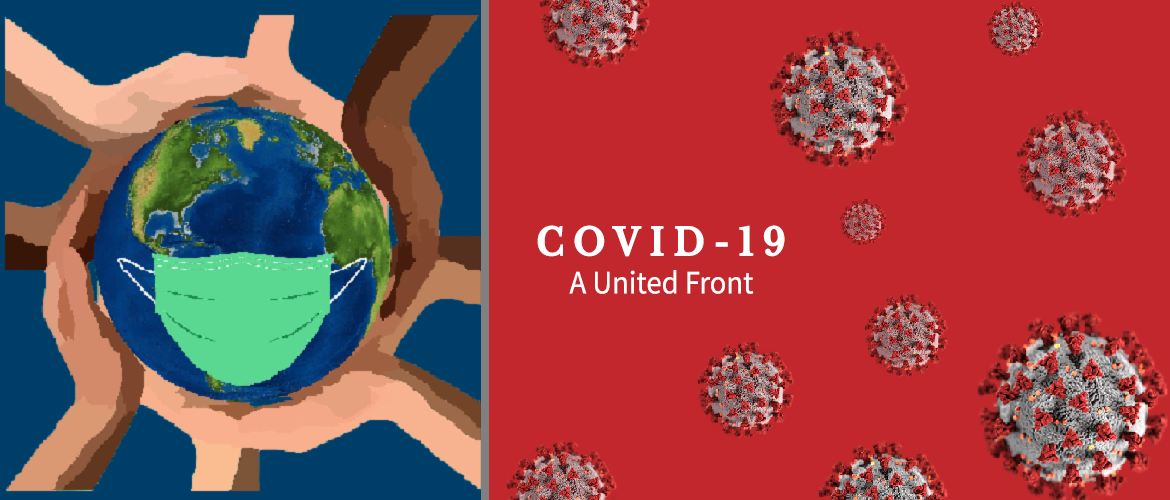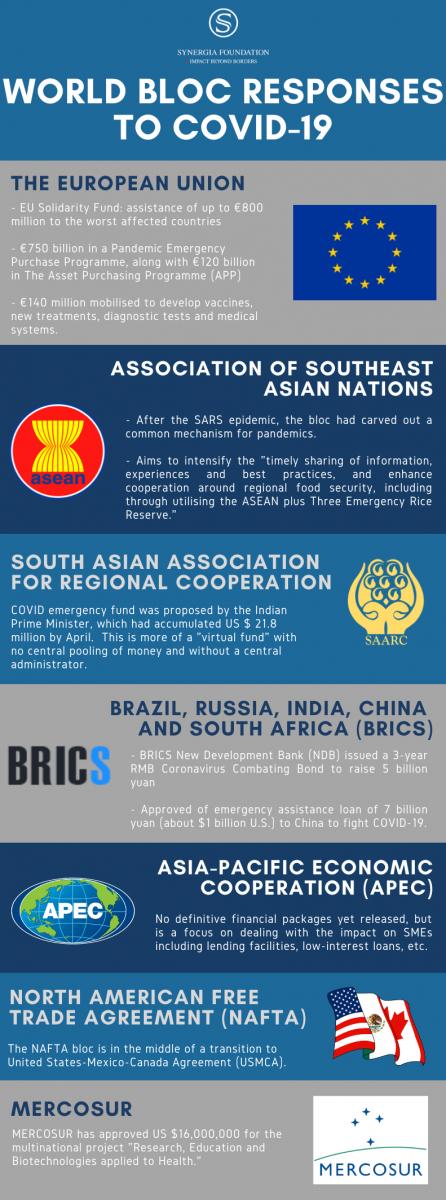COVID 19 - A United Front
April 27, 2020 | Expert Insights

Crumbling in the face of crisis
In an era of globalisation, many countries have integrated to form regional Free Trade Areas or blocs to bring affluence to their public through trade. Sadly, in the face of the pandemic, as each country husbands its resources, the common interests of the bloc are suffering. This was well enunciated by the Italian Prime Minister when he called for a coordinated response across the world’s largest trading blocs and reminded them that European Union (EU) leaders faced an appointment with history that they could not miss.
The European Union
The status of collaboration between European Union states was summarised by the Commission President, Ursula von der Leyen on 16th April in the European Parliament. She conveyed a 'heartfelt apology' to Italy on behalf of Europe for failing to come to aid at the most perilous times. She went on to claim that "Europe has now become the world's beating heart of solidarity." She was referring to fresh joint initiatives of member countries to share medical equipment, fly-in patients from worst-affected countries and initiating the process of financial recovery.
The first signs of a collaborative effort are now visible in the EU. The priority of the EU is to combat the pandemic jointly. There is a joint effort to increase the production of masks and other PPE, hand sanitizers and disinfectants by using 3D printing. To ensure seamless distribution, special ‘green lanes’ are being created to avoid stoppages at any key internal border points.
The economic impact of COVID-19 across EU members has been disparate with Spain and Italy bearing the brunt. The European Commission has tried to cushion the economic impact through emergency measures, including the release of billions of euros to maintain liquidity of banks and relaxing fiscal rules enabling flexible economic response by members. An EU Solidarity Fund of €800 million will assist in the recovery of the worst-affected countries. European Central Bank’s €750 billion Pandemic Emergency Purchase Programme is a new temporary asset purchase program of private and public sector securities. The Commission has also mobilised up to €140 million to help R&D in vaccines, new treatments, diagnostic tests and medical systems.
Association of Southeast Asian Nations (ASEAN)
After the SARS epidemic, the bloc had carved out a common mechanism for pandemics. This had seven components- Senior officers Health Meetings, Emergency Operations Centre Network (Malaysia), Field Epidemiology Training Network (Malaysia and Thailand), Bio Diaspora Virtual Centre for Big Data Analytics (Philippines), Risk Assessment & Risk Communication Centre (Malaysia), Regional Public Health Laboratory Network and Public Health Laboratory Network for health hazards. These mechanisms did not come up to the expectations as the suddenness of the pandemic allowed little space of coordination. It was every country for itself when the epidemic first struck.
ASEAN sought cooperation from China, Japan and South Korea in helping ASEAN fight the coronavirus. ASEAN aims to intensify the "timely sharing of information, experiences and best practices, and enhance cooperation around regional food security, including through utilising the ASEAN plus Three Emergency Rice Reserve." The ASEAN Risk Assessment and Risk Communication Centre, hosted by Malaysia, has now taken the lead in risk communication initiative for public communications throughout the bloc. An ASEAN Response Fund is proposed, but details are not yet clear.
South Asian Association for Regional Cooperation (SAARC)
India convened a video summit meeting of SAARC heads of state on 16th March intending to create a space for a joint action-plan in South Asia. On 15th March 2020, the COVID emergency fund was proposed by the Indian Prime Minister, which had accumulated US $ 21.8 million by April. This is more of a "virtual fund" with no central pooling of money and without a central administrator. Each member would take its own decision on implementation of their commitments. India has also offered assistance in material and services to neighbouring countries if required and Armed Forces Humanitarian Assistance Teams have been placed on standby for this purpose.
India's initiative had revived hope amongst member countries that the largest economy of the region would perhaps revive this moribund bloc.
Brazil, Russia, India, China and South Africa (BRICS)
For the BRICS countries, the OECD predicts a potential GDP decline at constant prices of over 20 percent in Brazil and India, 23 percent in Russia, about 19 percent in China, and 17 percent in South Africa.
The BRICS New Development Bank (NDB) issued a 3-year RMB Coronavirus Combating Bond to raise 5 billion yuan (706 million U.S. dollars. NDB has also approved an emergency assistance loan of 7 billion yuan (about $1 billion U.S.) to China to fight COVID-19. However, the BRIC countries so far have not come together to form any joint strategy against COVID-19, although, during the recovery phase, they may collaborate to expedite the recovery process.

Asia-Pacific Economic Cooperation (APEC)
Member Economies: Australia; Brunei Darussalam; Canada; Chile; China; Hong Kong, China; Indonesia; Japan; Korea; Malaysia; Mexico; New Zealand; Papua New Guinea; Peru; Philippines; Russia; Singapore; Chinese Taipei; Thailand; United States of America; and Viet Nam.
Health officials of APEC convened in Malaysia discuss strategies for the surveillance and management of the outbreak of. APEC economies are also examining supply-side strategies to strengthen vaccine-based public health responses. "Saving lives is obviously what matters most right now," said the Chair of the APEC Business Advisory Council (ABAC), Dato Rohana Tan Sri Mahmood. "This demands collaboration across the region on the knowledge and the tools we need to combat the health impacts and mitigate the most severe economic consequences in the short term," she added.
While no definitive financial packages have yet been released by APEC, there is a focus on dealing with the impact on SMEs including lending facilities, low-interest loans, moratoriums on rental payments, tax deferrals, and wage subsidies for three months. This is guesstimated to amount to USD 471 billion.
North American Free Trade Agreement (NAFTA)
The NAFTA bloc is in the middle of a makeover, trying to change its image to the United States-Mexico-Canada Agreement (USMCA). While Canada and Mexico have come on board with the plan this year, the U.S.A's stance on the agreement still stands to be seen.
The NAFTA 2.0 deal does, however, emphasise an "enforceable biotechnology chapter," as per the council. The deal is taking a backseat as each country deals with COVID-19 on its terms.
MERCOSUR
Member countries: Argentina, Brazil, Paraguay and Uruguay, and later joined by Venezuela and Bolivia.
Also called the Southern Common Market, MERCOSUR has approved US$ 16,000,000 for the multinational project "Research, Education and Biotechnologies applied to Health," to support the fight against COVID-19.
Analysis
Trade blocs tend to exploit the geographical proximity of members to lower overheads like transportation costs. Trading blocs also lend a sense of security as a guarantee of benefits from neighbours. The EU, although severely hit and slow in its response, appears to be doing a better job overall than other blocs in the recovery efforts.
Multilateral institutions have to step in now to prevent restrictive trade practices and the imposition of export bans by countries manufacturing critical medicines and PPE. From the beginning of the year and up till 21st March 2020, 46 export curbs on medical supplies have been introduced by 54 governments, creating a critical shortage of essential medical supplies.
Not every nation has the medical supplies needed to tackle COVID-19. India delivered hydroxychloroquine to nearly 55 countries including the U.S. India also lifted the export bans two weeks after enforcing them. India in turn, requires help from its strategic partners over equipment issues like ventilators. Ease of trade during trying times like a pandemic is key to ensure no one country gets left behind.
Assessment
That the COVID 19 is now a full-blown global crisis—medical, societal, and commercial—is no longer in doubt. Trade blocs help by providing a safety net of sort and work towards building stronger relations, which come in handy during times like these.
Bloc trade policy should, however, enhance rather than reduce the effectiveness of public health interventions. The proper account should be taken of relevant trade-health linkages, informed by expert advice, and those trade policies that deprive buyers worldwide of medical supplies must be lifted in times of crises.
The self-centred approach to deal with this unexpected pandemic, which has spared no country, has weakened even blocs like the EU. It has exposed the deep social inequalities and animosities between member states. If bloc members fail to come to the aid of the worst affected members now, then it puts under a cloud the quest for long term prosperity through integration, unity and economic cohesion.








Comments